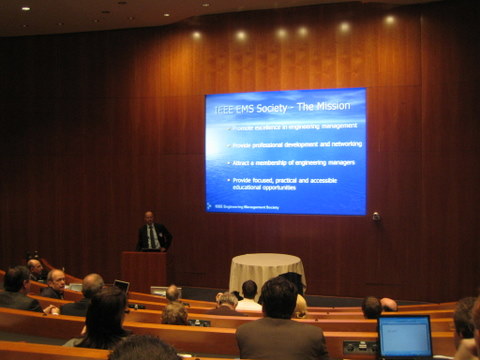OK, es geht weiter. Die erste Session verspricht interessant zu werden – Siegfried Hirsch wird zu Enterprise RSS (wo einsetzen, welche Inhalte, …) sprechen:
Das Blog von Siegfried Hirsch beschäftigt sich mit Nutzen und Anwendung der Content Syndication mit Hilfe von WebFeeds und den Formaten RSS, RDF und Atom.
Stichworte aus dem Vortrag, ergänzt um die eine oder andere Ergänzung:
– Vorstellungsrunde der Teilnehmer (interessante Mischung, u.a. auch Fragen nach sicheren RSS-Feeds, Scuttle etc.)
– Information Overload (nicht nur durch unternehmensinterne Email, aber die CC-Unkultur macht hier schon mal viel aus, Email ist für One2One gut geeignet, nicht aber für One2Many)
– Lösungsansatz RSS (verwendbar für Intranet-Portale, Unternehmenswikis, Weblogs, Social Bookmarking etc etc etc)
– RSS kann ja auch wieder aggregiert, gefiltert etc. werden (sieht man bspw. sehr schön in dieser Visualisierung von Fred Cavazza) … bzw. als “Futter” für den Aufbau einer personalisierten Wissens- und Dokumentenbasis verwendet werden (bspw. indem die Inhalte der abonnierten Feeds bei Bloglines dauerhaft gespeichert werden)
– Kurz zur Motivation Portale durch Wikis zu ergänzen (und vielleicht auch manchmal zu ersetzen)
– Stolpersteine beim Einsatz von RSS im Unternehmen (Anforderungen an IT, vergrößerte Sicherheitsrisiken durch RSS-Reader mit “Browsing”-Funktionalität)
Im Mittelpunkt der Probleme: interne Inhalte können nicht ausgeliefert werden – interne Feeds sind (sinnvollerweise) HTTPS und SSL-geschützt (und hinter der Firewall), in der Folge werden interne Reader notwendig, diese haben aber erhebliche Bandbreitebedarfe und benötigen Spezialkompetenzen in der internen IT-Abteilung.
– Lösungsansatz Enterprise-RSS-Server (bspw. Newsgator, Attensa, KnowNow, David R10)
Zentral: Auslieferung von internen Inhalten – sei es Blogs, Wikis, Portale + CMS etc etc., ebenso die Integration von nicht web-tauglichen Quellen (könnten ja bspw. auch Reports aus Business Intelligence Systemen, Datenbank-Abfragen, etc. sein, frogpond)
Daneben auch wichtig: Unterstützung von Zusammenarbeit, zuverlässige Zugriffskontrolle (bspw. durch LDAP), Auswertung von Feeds und Optimierung, Filtern, gesteigerte Sicherheit und geringere IT-Anforderungen.

